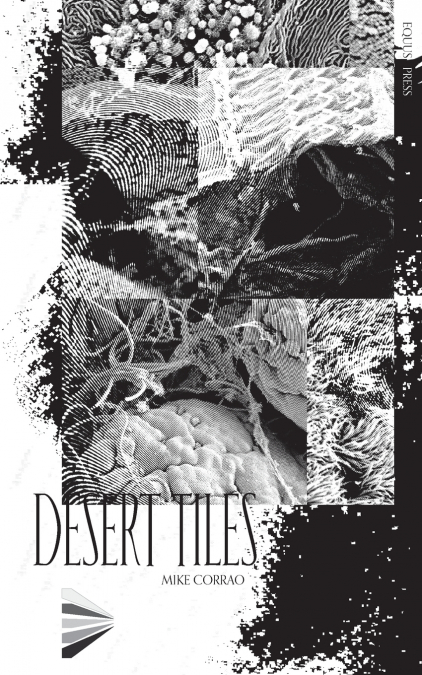
Mike Corrao
Desert Tiles brings a fresh spin on the 'Corraoesque' theme of text / image coming 'alive', becoming a 'semiotic organism,' undertaken here via the twin metaphors of text as a desert and reading as necromancy. The desert here is both literal (as the ever-shifting 'dune-script' of meaning) and a place 'deserted', a place of the always-already absent voice, into which the reader is invited to venture out. Reading as necromancy entails summoning the voice of the absent/'dead' author, communing with the past action(s) of signification and by decoding it, yielding messages for (some kind of) the future.'Read this geometry in such a way as to allow the text unit increment itself to be unbounded, allowing for fragments of itself to be discorporated in such a way as to interlock-in voxelized gradient-with vacancies identical to those fragments excised from the primary corpus of the text unit itself in such a way as to be both of itself and containing another, like a splinter of bone healing into liver tissue.'-John Trefry, author of Plats'Mike Corrao’s Desert Tiles takes an ekphrastic approach to our probable swallow by ocular data. The writer/reader is in a state of pixelated becoming. There is no what it/we/they become(s), nor how, nor why, even - a barely-where 'textures are compressed and corrupted' and a barely-who 'hums their jaw against the sand.' Something is in process of being downloaded, devoured, dissolved. It’s icky, because it’s true. What happens when the happening is pure mechanics, an I thinking and therefore (without reason). As the body is desertified, the body-esque remains: a fine-grained graphic that 'yawns and weeps' even while you (the body? Or body-esque?) 'want to cry, but are incapable.' In the poem 'you ask yourself if this still counts as lived experience,' while IRL you are wondering if you count as something R and L? Or 'is its not being real really that important?' A proper noun believes in something, like the moon landing, or politics, or that 7up & saltines will cure a stomachache. 'The static speaks to me.' Poor robots, I think, poor tin man. A heart and blood are black and white and indexed quietly, and the index beats. Who will read all the indexes left behind, desiring their un-deserted world? One might desire the desert. Liking the gray sand. And then what.'-MJ Gette, author of The Walls They Left Us'Set in a desert created by a ’borgesian deity,’ a wandering ’wastrel-form’ encounters a Necromancer. This isn’t the Desert of the Real, but a literary simulacrum where wanderer and Mancer engage in a dance of death (or birth)? Corrao reveals a book giving birth to itself, not as a postmodernist contrivance, but as a slow-paced prose poem. Body horror collides with a kind of digital mysticism. With both words and images, we witness a sky the color of TV tuned to a dead channel and the birth of the new flesh.'-Driftless Area Review